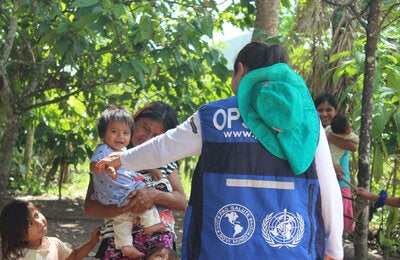Experience from past disasters suggests that women and children in Haiti may not be getting a fair share of the massive relief aid that is pouring into the country following last week's earthquake, say public health experts at the Pan American Health Organization/World Health Organization (PAHO/WHO).
"I am deeply disturbed by pictures in the media of Haitians lined up and receiving relief aid, and they are all men," said Dr. Marijke Velzeboer-Salcedo, PAHO/WHO's top expert on gender issues. "We're seeing images in newspapers and on TV with only men, or a majority of men, standing or pressing themselves forward in food or water lines. We can't help but wonder, where are the women? Have they all entrusted their survival tasks to their men? Do we know that resources are getting shared equally by these men and other members of their families?"
Women and children are especially vulnerable following a disaster, Velzeboer-Salcedo and other experts say. This is especially true in Haiti, where rates of violence against women and girls were already high before the earthquake.
In a study carried out by the Inter-American Development Bank in Haiti in 2006, one-third of women and girls said they had suffered physical or sexual violence, and more than 50 percent of those who had experienced violence were under the age of 18.
"We hope and pray that security can prevent and control violence against women," said PAHO Deputy Director Dr. Jon Andrus, citing reports of increasing violence in the earthquake's aftermath.
"We have to keep in mind that disasters make existing inequalities even worse," said Velzeboer-Salcedo. "Those who are stronger and more powerful, whether physically or psychosocially--or both--are going to have better access to scarce resources. But when women are deprived of resources, entire families are likely to be deprived, too."
Both experts called on relief organizations to address the different needs of women, girls, boys, and men by conducting needs assessments that take gender differences into account, and by ensuring that both men and women are on assessment teams.
Data collected by relief organizations on deaths, injuries, displacement, and who is receiving aid should be gathered and analyzed by sex and age. This is critical for targeting services and assistance according to actual needs, said Velzeboer-Salcedo.
Women face other special challenges in the aftermath of disasters. For example, young children and pregnant and nursing mothers are considered at higher risk of moderate or severe acute malnutrition, as are older people.
The danger of malnutrition rises when, due to the disruptive effects of a disaster, women stop breastfeeding their infants or fail to initiate breastfeeding of their newborn babies.
"With water and sanitation systems failing, it is even more important for mothers to breastfeed their babies rather than giving them formula mixed with water that may very well be contaminated," said Dr. Chessa Lutter, a PAHO/WHO nutrition expert.
Velzeboer-Salcedo also called on relief workers to be alert for cases of sexual violence, exploitation, and abuse.
"It takes extra awareness and effort to empower women, who are the main caretakers of the injured and families during these tragic circumstances," she said.
PAHO was established in 1902 and is the world's oldest public health organization. It works with all the countries of the Americas to improve the health and quality of life of the people of the Americas and serves as the Regional Office for the Americas of the World Health Organization (WHO).
Links
- PAHO Disasters & Humanitarian Assistance website
- Donate to Haiti Earthquake Relief
- Twitter, PAHO Emergency Operations Center
- PAHO YouTube Channel
- PAHO Facebook page
- PAHO/WHO Twitter
For more information please contact: Donna Everwine Villagran Tel. 202 974 3122 or Daniel Epstein, Tel. 202 316 5679.



